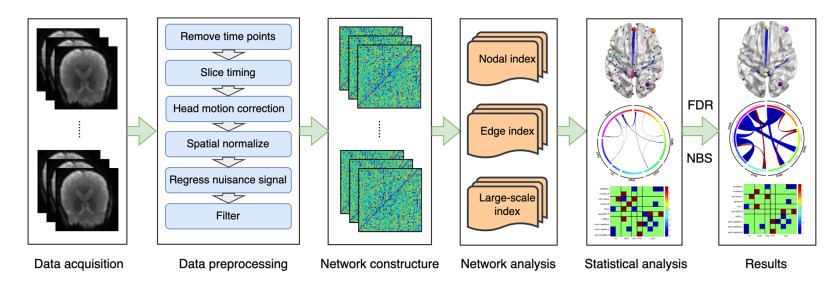近日,研究中心博士生李翔的一篇论文“Aberrant intrinsic functional brain topology in methamphetamine-dependent individuals after six-months of abstinence”被Mathematical Biosciences and Engineering刊发。(论文链接地址:https://doi.org/10.3934/mbe.2023867)

论文摘要:论文的目的是利用静息态功能磁共振成像(Rs-fMRI)研究甲基苯丙胺依赖者在戒断六个月后的异常内在功能拓扑结构。研究招募了11名戒断六个月的甲基苯丙胺成瘾和11名健康对照组,分别进行Rs-fMRI检查。采用图论和功能功能分析方法,从多个层面研究了两组患者大脑内在功能拓扑结构的异常。与健康对照组相比,特征最短路径长度在全局水平上显著下降,而全局效率和局部效率则显著上升。经FDR校正后,论文发现两组在腹侧注意网络、背侧注意网络、体感网络、视觉网络和默认模式网络的节点程度和节点效率在区域水平上存在显著的组间差异。此外,NBS方法还显示了两组被试的一些连接边存在显著的组间差异,主要分布在额顶网络、皮层下网络、腹侧注意网络、背侧注意网络、体感网络、视觉网络和默认模式网络。此外,大尺度脑功能网络发现视觉网络和皮层下网络内部以及两个网络之间的功能连接显著下降。上述研究结果表明,某些功能(如视觉处理能力、物体识别和记忆)在戒断六个月后可能无法完全恢复。这就导致了在面对与甲基苯丙胺相关的线索时出现复吸行为的可能性。此外,研究结果还为揭示戒断六个月后甲基苯丙胺成瘾的神经机制提供了影像学基础。
Abstract: Our aim was to explore the aberrant intrinsic functional topology in methamphetamine-dependent individuals after six months of abstinence using resting-state functional magnetic imaging (rs-fMRI). Eleven methamphetamines (MA) abstainers who have abstained for six months and eleven healthy controls (HC) were recruited for rs-fMRI examination. The graph theory and functional connectivity (FC) analysis were employed to investigate the aberrant intrinsic functional brain topology between the two groups at multiple levels. Compared with the HC group, the characteristic shortest path length showed a significant decrease at the global level, while the global efficiency and local efficiency showed an increase considerably. After FDR correction, we found significant group differences in nodal degree and nodal efficiency at the regional level in the ventral attentional network (VAN), dorsal attentional network (DAN), somatosensory network (SMN), visual network (VN) and default mode network (DMN). In addition, the NBS method presented the aberrations in edge-based FC, including frontoparietal network (FPN), subcortical network (SCN), VAN, DAN, SMN, VN and DMN. Moreover, the FC of large-scale functional brain networks revealed a decrease within the VN and SCN and between the networks. These findings suggest that some functions, e.g., visual processing skills, object recognition and memory, may not fully recover after six months of withdrawal. This leads to the possibility of relapse behavior when confronted with MA-related cues, which may contribute to explaining the relapse mechanism. We also provide an imaging basis for revealing the neural mechanism of MA-dependency after six months of abstinence.